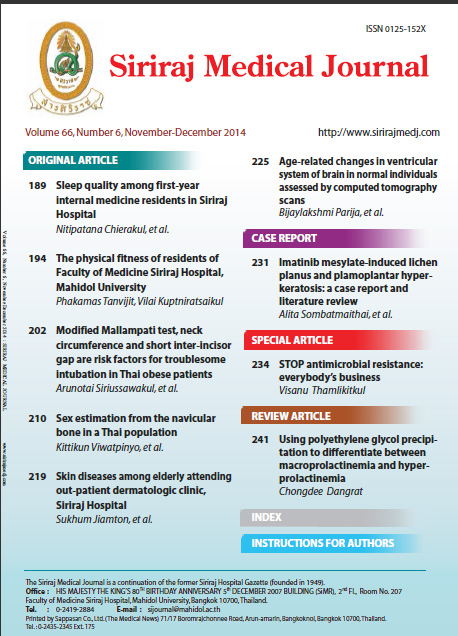Modified Mallampati Test, Neck Circumference and Short Inter-Incisor Gap Are Risk Factors for Troublesome Intubation in Thai Obese Patients
Abstract
Background: Several alternative airway tools have now become primary devices for endotracheal intubation in obese patients. Since there were no guidelines to suggest which patient characteristics may be best suited for alternative techniques, we conducted this study to identify which airway bedside tests could predict the occurrence of troublesome intubation while performing conventional endotracheal intubation in obese Thai patients.Methods: This cohort study was conducted in 200 obese patients who were expected to not use alternative tools for first-line management in a tertiary care university hospital. Troublesome intubation was defined using an intubation difficulty scale (IDS) score > 0. An IDS value of 0 means ideal intubation, i.e., one performed without effort, on the first attempt, practiced by one operator, using one technique, with no impediment of the tube passage. Eleven types of preoperative airway assessment – including malformation of central teeth in the upper jaw, a modified Mallampati test, an upper-lip bite test, the range of motion of the neck (flexion and extension), the inter-incisor gap, the hyomental distance, the thyromental distance, the sternomental distance, the neck circumference, and the length of the neck – were examined in all patients.
Results: The inter-observer reliability of raters was > 0.7 before initiation of the study. Overall, 52.5% of patients experienced troublesome intubation during conventional endotracheal intubation. According to a multivariate analysis, the independent risk factors were a modified Mallampati test, the neck circumference, and the inter-incisor gap.
Conclusion: Based on our findings, alternative airway tools should be the first line of airway management in the case of patients with a high modified Mallampati test, a large neck circumference, and a short inter-incisor gap.
Keywords: Difficult intubation, prediction, airway assessment, obesity
Downloads
Published
How to Cite
Issue
Section
License
Authors who publish with this journal agree to the following conditions:
Copyright Transfer
In submitting a manuscript, the authors acknowledge that the work will become the copyrighted property of Siriraj Medical Journal upon publication.
License
Articles are licensed under a Creative Commons Attribution-NonCommercial-NoDerivatives 4.0 International License (CC BY-NC-ND 4.0). This license allows for the sharing of the work for non-commercial purposes with proper attribution to the authors and the journal. However, it does not permit modifications or the creation of derivative works.
Sharing and Access
Authors are encouraged to share their article on their personal or institutional websites and through other non-commercial platforms. Doing so can increase readership and citations.










